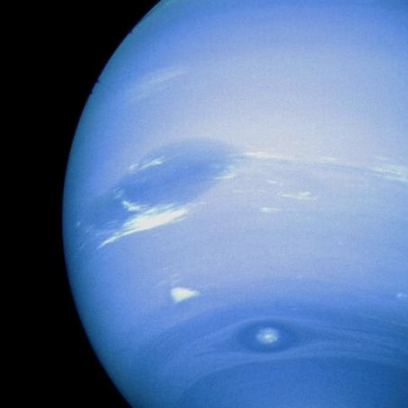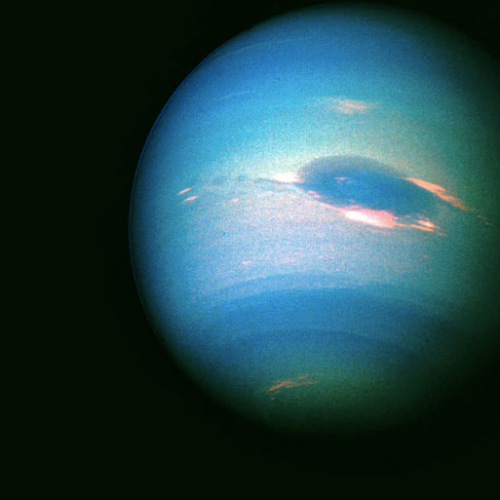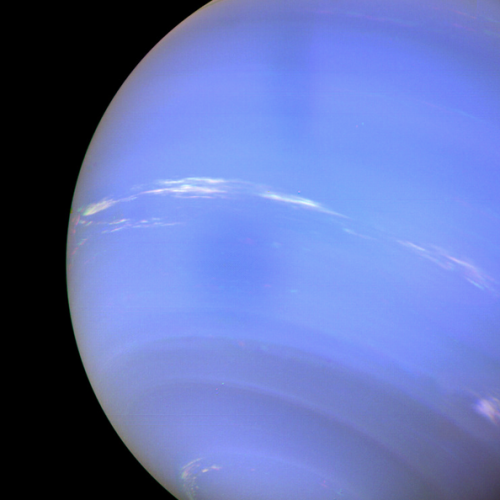Neptune!
Neptune!
Mercury will always be my favorite planet (closest to the Sun, underappreciated, proved Einstein’s general relativity, among other things) but I think Neptune’s the most beautiful. Look at that hue!
WANT MORE? GET YOUR HEAD STUCK IN THE STARS AT MY BLOG!






neptune.
More Posts from Acosmicgeek and Others
Omg yes this is it - this is the unified theory of everything - Einstein was just a lion the whole time!
It does explain the hair though
WANT MORE? GET YOUR HEAD STUCK IN THE STARS AT MY BLOG!

The physics lion
You could say that they’re very ... NOBLE!
hehe
WANT MORE? GET YOUR HEAD STUCK IN THE STARS AT MY BLOG!

i hope i translated it correctly
That’s how I want the world to end
better than us all getting killed by a pandemic or a nuke
WANT MORE? GET YOUR HEAD STUCK IN THE STARS AT MY BLOG!

On November 12, 1833, there was such an intense meteor shower that it was possible to see up to 100,000 meteors crossing the sky every hour. At the time, many thought it was the end of the world, so much that inspired this wood engraving by Adolf Vollmy.

THE LIFE OF A STAR: A DAY IN THE LIFE
Stars are born, and then they live. If a body is large enough and has enough pressure in its core, it will squeeze to fuse hydrogen. The hydrogen in a star's core fuses into helium, releasing photons and fueling the star. The heat created in this process attempts to expand the star, but as their gravity is so strong which threatens to collapse them (making it a problem once fusion stops - we'll get to this later!), this creates an equilibrium. And while stars have some things in common, they do have unique qualities of their own.
Here are the properties that all main sequence stars share: hydrogen fusion, hydrostatic equilibrium ("the inward acting force, gravity, is balanced by outward acting forces of gas pressure and the radiation pressure"), the mass-luminosity relationship (in other words, the more massive a star, the brighter it is), it is the stage where stars spend the most of their lives, and a composition made almost entirely of hydrogen and helium (ATNF - Australia Telescope National Facility).
Like the planets and our sun, stars have structure. The layers of a star are as follows, from the innermost to the outermost: the core, the radiative and convective zones, the photosphere, the chromosphere, and the corona. The structure of our Sun is illustrated above.
The core of a star undergoes fusion in order to maintain hydrostatic equilibrium, and prevent the star from collapsing in on itself. As such, the core is the hottest and most dense region of a star (Universe Today). Thermonuclear energy spreads from the core through convection, the process by which heat moves: heat moves up and cold moves down because cold has a higher density than hot (Britannica: convection). Furthermore, some stars are fully convective, while others just have regions of convection. "The location of convection zones is strongly dependent on the star’s mass. Cool and low-mass stars are fully convective ... Stars slightly more massive and warmer than the Sun, also form a convective core." (Stellar Convection). I'll touch on this in the next chapter, where small stars such as Red Dwarfs are fully convective and are able to avoid the Red Giant phase, due to a lack of build-up of particles in their cores.
In radiative zones, this energy is carried by radiation. In convective zones, it is carried by convection. These zones are not hot or dense enough to undergo nuclear fusion. The photosphere is the surface of a star, then the inner atmosphere (colored red due to the abundance of hydrogen) is the chromosphere, and the outermost atmosphere is the corona (space.com).
In terms of stellar composition, they are mainly composed of hydrogen and helium (which also happen to be some of the most abundant elements in the universe and are the fuel behind a star's nuclear fusion), but also include heavier elements (such as carbon and oxygen). As observed by spectrums and other observations, stars with a greater amount of heavier elements are typically younger because older stars give these elements off due to mass-loss (ATNF - Australia Telescope National Facility).
Stars also undergo atomic and molecular processes internally to maintain their hydrostatic equilibrium:
The Proton-Proton Cycle is the main source of energy for cool main-sequence stars, such as the Sun. This cycle fuses four hydrogen nuclei (aka, protons) into one helium nucleus and two neutrinos (some of the original mass is converted into heat energy). Two hydrogen nuclei combine and emit a positron (a positively charged electron) and a neutrino. The hydrogen-2 nucleus captures a proton to become hydrogen-3 and emit a gamma-ray. There are multiple paths after which, but it always results in the same (Britannica: proton-proton cycle).
The CNO Cycle (aka the Carbon-Nitrogen-Oxygen Cycle) is the main source of energy for warmer main-sequence stars. This cycle has the same resultants but the process is much different. *SKIP AHEAD TO AVOID MY NERD RANT* It fuses a carbon-12 nucleus with a hydrogen nucleus to form a nitrogen-13 nucleus and a gamma-ray emission. The nitrogen-13 emits a positron and becomes carbon-13, which captures another proton/hydrogen nucleus and becomes nitrogen-14 and another gamma-ray. The nitrogen-14 captures a proton to form oxygen-15 and then ejects a positron and becomes nitrogen-15. This, of course, captures another proton and then breaks down into a carbon-12 nucleus and a helium nucleus (an alpha particle). *JUST IN CASE YOU SKIPPED AHEAD* TLDR, it ends up as helium. Nuclear fusion, folks, it's weird (Britannica: CNO cycle).
The products of these processes aren't just automatically transferred and radiated away from the star. No, first they must make their way through the radiative and convective zones. Neutrinos travel almost at the speed of light, and so are the least affected. Photons also lose some energy during the journey, due to interactions with other particles. This energy heats up the surrounding plasma and keeps it flowing, in turn the convection currents transport energy to the surface (ATNF - Australia Telescope National Facility).
Even though a star spends most of its life in the main-sequence stage, this cycle of processes and equilibrium ends eventually. In the next chapter, we'll be talking about what happens after a star runs out of hydrogen to fuse - Giant and Super-Giant Stars.
The rate at which a star runs through its hydrogen is proportional to its mass: the greater the mass, the faster it runs through hydrogen, and vice versa (Britannica: star). Then the star will begin to fuse the heavier elements until it meets its match: iron. Then things get real ... explosive.
First - Chapter 1: An Introduction
Previous - Chapter 4: A Star is Born
Next - Chapter 6: The End (But Not Really)
WANT MORE? GET YOUR HEAD STUCK IN THE STARS AT MY BLOG!
Omg particles are such players - JUST CHOOSE ONE!!!
But yeah wave-particle duality is kinda confusing sometimes lol
Like, how is it both? I dunno! Maybe I’ll read up on that later ...
WANT MORE? GET YOUR HEAD STUCK IN THE STARS AT MY BLOG!

Photons : Hello I’m a particle . Oh yeah but i behave like a wave too , isn’t that beautiful !!
How do I constantly forget how beautiful the universe is?
Also, this is true, Jewels DEFINITELY aren’t as bright as stars!
WANT MORE? GET YOUR HEAD STUCK IN THE STARS AT MY BLOG!

A Stellar Jewel Box: Open Cluster NGC 290 : Jewels don’t shine this bright – only stars do. Like gems in a jewel box, though, the stars of open cluster NGC 290 glitter in a beautiful display of brightness and color. The photogenic cluster, pictured here, was captured in 2006 by the orbiting Hubble Space Telescope. Open clusters of stars are younger, contain few stars, and contain a much higher fraction of blue stars than do globular clusters of stars. NGC 290 lies about 200,000 light-years distant in a neighboring galaxy called the Small Cloud of Magellan (SMC). The open cluster contains hundreds of stars and spans about 65 light years across. NGC 290 and other open clusters are good laboratories for studying how stars of different masses evolve, since all the open cluster’s stars were born at about the same time. via NASA

Full Moon day!!!
WANT MORE? GET YOUR HEAD STUCK IN THE STARS AT MY BLOG!
Poor, poor moon :(
WANT MORE? GET YOUR HEAD STUCK IN THE STARS AT MY BLOG!

“boy, girl, time for dinner!”
Wow, Mars is one of the closest planets to us xD
Just shows you how massive space really is
(Maybe even infinitely so)
WANT MORE? GET YOUR HEAD STUCK IN THE STARS AT MY BLOG!

This is what the Earth looks like from the surface of our red neighbour, Mars!
Happy Earth day everyone 🌎🌍🌏 Hope you’re all staying safe!!
Image Credit: NASA’s Curiosity Mars Rover
Dark matter is one of my favorite mysteries in Astrophysics, oh I would just love to study it. Some are using particle accelerators to try to study DM and figure out what it is - and it’s so so exciting!!!
WANT MORE? GET YOUR HEAD STUCK IN THE STARS AT MY BLOG!

I love this meme format
-
 stefastral liked this · 3 weeks ago
stefastral liked this · 3 weeks ago -
 budsmoke liked this · 1 month ago
budsmoke liked this · 1 month ago -
 imageness-retro reblogged this · 1 month ago
imageness-retro reblogged this · 1 month ago -
 imageness-retro liked this · 1 month ago
imageness-retro liked this · 1 month ago -
 legendaryoffebruary reblogged this · 1 month ago
legendaryoffebruary reblogged this · 1 month ago -
 legendaryoffebruary liked this · 1 month ago
legendaryoffebruary liked this · 1 month ago -
 devildionysos liked this · 2 months ago
devildionysos liked this · 2 months ago -
 carpusofbonees reblogged this · 2 months ago
carpusofbonees reblogged this · 2 months ago -
 whonmyeys liked this · 2 months ago
whonmyeys liked this · 2 months ago -
 m3ybuz reblogged this · 2 months ago
m3ybuz reblogged this · 2 months ago -
 alwaysthird reblogged this · 2 months ago
alwaysthird reblogged this · 2 months ago -
 missdiamantata liked this · 2 months ago
missdiamantata liked this · 2 months ago -
 eiie1 reblogged this · 2 months ago
eiie1 reblogged this · 2 months ago -
 carolannduffy reblogged this · 3 months ago
carolannduffy reblogged this · 3 months ago -
 redredred0 reblogged this · 4 months ago
redredred0 reblogged this · 4 months ago -
 oweztopoczuj reblogged this · 4 months ago
oweztopoczuj reblogged this · 4 months ago -
 naturetamed liked this · 4 months ago
naturetamed liked this · 4 months ago -
 room-of-flint reblogged this · 4 months ago
room-of-flint reblogged this · 4 months ago -
 the-freexone-experience reblogged this · 4 months ago
the-freexone-experience reblogged this · 4 months ago -
 the-freexone-experience liked this · 4 months ago
the-freexone-experience liked this · 4 months ago -
 es-denkt-mir reblogged this · 4 months ago
es-denkt-mir reblogged this · 4 months ago -
 frumpybutsupersmart reblogged this · 4 months ago
frumpybutsupersmart reblogged this · 4 months ago -
 shadowqween reblogged this · 4 months ago
shadowqween reblogged this · 4 months ago -
 lilliput-army liked this · 4 months ago
lilliput-army liked this · 4 months ago -
 nagasarennayoex reblogged this · 4 months ago
nagasarennayoex reblogged this · 4 months ago -
 thatboysouth liked this · 4 months ago
thatboysouth liked this · 4 months ago -
 575hz reblogged this · 4 months ago
575hz reblogged this · 4 months ago -
 dyled liked this · 5 months ago
dyled liked this · 5 months ago -
 mr-noboty reblogged this · 5 months ago
mr-noboty reblogged this · 5 months ago -
 merfolkplantgay reblogged this · 5 months ago
merfolkplantgay reblogged this · 5 months ago -
 silberpilz liked this · 5 months ago
silberpilz liked this · 5 months ago -
 iganimedes liked this · 5 months ago
iganimedes liked this · 5 months ago -
 stevianooo liked this · 5 months ago
stevianooo liked this · 5 months ago -
 no1248 liked this · 5 months ago
no1248 liked this · 5 months ago -
 super-mega-foxy-awesome-hawt liked this · 5 months ago
super-mega-foxy-awesome-hawt liked this · 5 months ago -
 dlyn22ref reblogged this · 5 months ago
dlyn22ref reblogged this · 5 months ago -
 antho-vz liked this · 5 months ago
antho-vz liked this · 5 months ago -
 gattonegrro reblogged this · 5 months ago
gattonegrro reblogged this · 5 months ago -
 pyrophoricqueer reblogged this · 5 months ago
pyrophoricqueer reblogged this · 5 months ago -
 yourdadsghoulfriend reblogged this · 5 months ago
yourdadsghoulfriend reblogged this · 5 months ago -
 psychogrippysockjailgf liked this · 5 months ago
psychogrippysockjailgf liked this · 5 months ago -
 i66s liked this · 5 months ago
i66s liked this · 5 months ago -
 imageness-retro reblogged this · 5 months ago
imageness-retro reblogged this · 5 months ago -
 zigzagsanddimebags liked this · 6 months ago
zigzagsanddimebags liked this · 6 months ago -
 psylollie liked this · 6 months ago
psylollie liked this · 6 months ago -
 tea-time-at-livadia reblogged this · 6 months ago
tea-time-at-livadia reblogged this · 6 months ago
